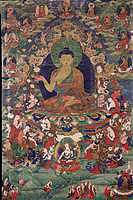|
  
After the Buddha passed into final Enlightenment, of Pari-Nirvana, mounds were
constructed to hold his remains. These mounds are known as Stupas or Chandis. They
serve as reminders to the faithful of the possibility of Enlightenment, and are
believed to hold bits of the ashes of the burnt body of the Buddha. Faithful
Buddhists often circumambulate, or walk around, these stupas while performing
meditations.
The central figure depicts the embodied Buddha teaching,
while the painting on the left shows the
space around the Stupa is full of little stupas, to indicate that
Enlightenment is actually everywhere. In the image on the right, the central
Stupa of the Buddha Gautama is surrounded by seven stupas , representing the
previous Buddhas of this Eon, while at the peak of the Stupa are Vajrasattva,
Manjushri, and Amitabha, representing the ultimate Buddha, Dharma, and Sangha.
These three, and other important figures of the pantheon will be discussed
shortly.
The Buddha did not claim to be the first or only Buddha. He described himself
as one of the thousands of Buddhas to gain Enlightenment during our fortunate
eon. He was the seventh of these. Our own eon, in turn, is merely one in an
endless series of eons. Thus there have been countless Buddhas and there will be
unlimited more.
The Buddha portrayed at the left with two Bodhisattvas in
attendance is surrounded by eight mirror images of himself. This represents
the manifestation of Enlightenment and the desire to become enlightened in the
four cardinal directions and four intermediary directionsÑ—in short,
everywhere. In the background are a large host of Buddhas, indicating the
the omnipresence of Enlightenment. Below these
Buddhas are a host of male and female practitioners of Yoga, and, above
them, a caravan of followers riding every imaginable conveyance. Thus we see the
Buddha attended by lay people in a space and time where everything is
illuminated, and supported by the commerce of the caravan and the practice of
those devoted to austerity, none of whom appear to be monks or nuns.
The blue color of the central Buddha, the herb in his right hand and bowl in his
left, indicate that here, he is manifesting as the king of Medicine
Baishajaguru. This is both a reference to the Buddha's stylization of himself
as a healer of the sufferings of living beings and indication that the art of
healing is propagated by both commercial efforts and the practices of those
willing to explore various austerities. This illustrates one of the many ways that
Enlightenment is timeless, and that there are always and everywhere the
enlightened and those striving for Enlightenment.
|
